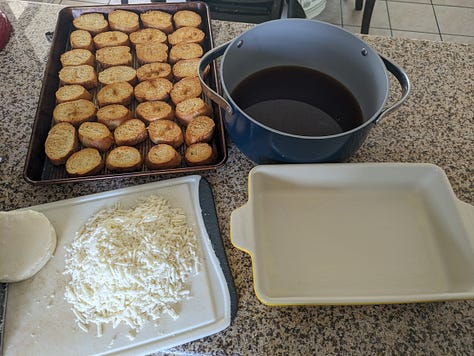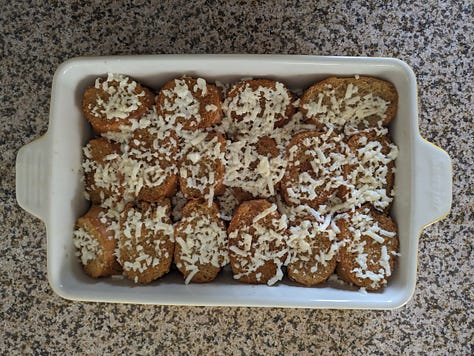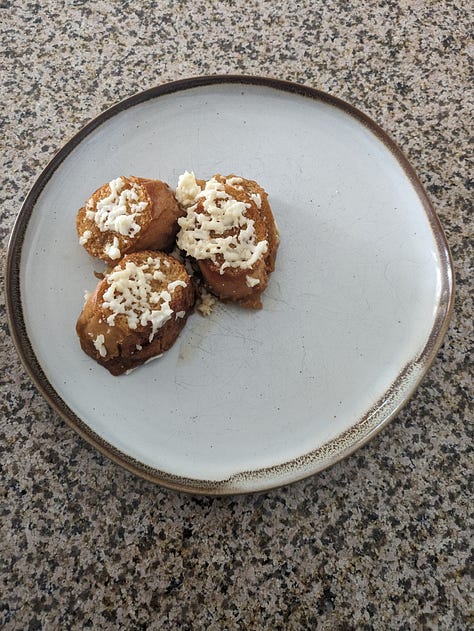Capirotada is a bread pudding eaten during the Lenten season in Mexico and Latin American countries. Believe it or not, this dish has its roots in the Roman Empire, where legions ate Sala Cattabia, a summer appetizer made of bread soaked in pusca (watered-down vinegar) with a cheese, garlic, and herb sauce and topped with snow. Apparently, the Romans were able to preserve snow for later use. The more you know.
Another ancestor of this dish is Almondrote, a 14th-century dish from Catalunya, Spain, which consists of slices of toasted bread soaked in lamb broth, topped with cheese and roasted garlic.
Capirotada in Spain was made by layering bread stuffed with pork loin, sausages, and cheese. Capirote is the name of a conical hat used by members of a confraternity of penitents during Holy Week. The cheese used in the recipe resembled the conical shape of the capirote, which is where it gets its name.
In New Spain, a.k.a. Mexico, capirotada took a religious symbolism. It became a tool for catechesis—the bread represents the Body of Christ, the syrup, the blood, and the cheese, the Holy Shroud. The syrup is made with piloncillo, solid molasses shaped like a cone (or capirote), two sticks of cinnamon to represent the cross, and three cloves to represent the nails.
Depending on where you are in Mexico, some people will add ingredients like raisins, nuts, bananas, and shredded coconut. Others make a tres leches syrup with milk, evaporated and condensed milk, but to make the simplest form of capirotada, you’ll need:
Ingredients
Six (6) day-old bolillos (kaiser rolls or demi baguettes work, too)
Two (2) piloncillo cones (8 oz each)
Two (2) cinnamon sticks
Three (3) cloves
Ten (10) oz queso fresco (crumbled or shredded)
One (1) stick of melted butter
Four (4) cups of water
Preparation
Cut the bread into half-inch slices and brush one side with butter. Place the bread on a baking sheet and toast in the oven at 350 F until golden brown, about fifteen minutes.
To make the syrup, add the water, piloncillo, cinnamon, and cloves to a saucepan, stirring the mixture on medium heat until the piloncillo is completely dissolved. Remove the cinnamon and cloves and let the syrup cool.
Brush the rest of the butter on a 13 x 9 baking dish. Submerge pieces of bread in the syrup and layer them on the baking dish. Sprinkle the cheese on top, and repeat the process until you have used all the bread and cheese. Scoop the rest of the syrup onto the dish, if any.
Feel free to add any extras between the layers if you so desire.
Pop it back in the oven to melt the cheese. Serve hot or at room temperature. If you are lucky enough to have leftovers, it also tastes great cold.



I know the addition of cheese sounds weird, but somehow it works. Each bite is buttery, sweet, and slightly salty. If you eat it right away, you may get some crunch from the toasted bread. I enjoy letting it sit so the bread gets mushy.
Feel free to scale the recipe up or down. The amounts I mention here serve ten people. Diana made me give some of it away because I would've eaten the whole thing if I didn't.
I hope you enjoyed this recipe and the history lesson. Now, you have a new dessert option for your Easter potluck. Better than peeps, that's for sure.
Peregrino is a reader-supported publication. To receive new posts and support my work, consider becoming a free or paid subscriber.
Before you go
Have you ever had Capirotada?
Would you make this dessert?
What's your stance on peeps?






I really might need to try this... Is it sweet enough to be dessert or is it more like a snack/appetizer?
My family always used white bread and peanuts instead of cloves. Thanks for sharing our cultura. 🕯️ Happy Holy Week 😊